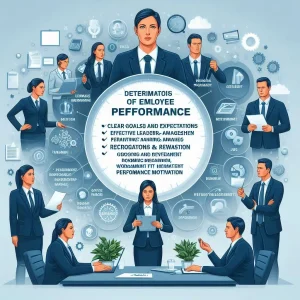Employee performance is the lifeblood of any successful organization. High-performing employees drive growth, innovation, and customer satisfaction, whereas underperformance can lead to stagnation and decline. Understanding what determines employee performance is essential for leaders aiming to foster a productive and engaged workforce. This article delves into the key determinants of employee performance and offers insights into how organizations can harness these factors to maximize their team’s potential.
1. Clear Goals and Expectations
Setting clear, achievable goals is fundamental. Employees need to understand what is expected of them and how their work contributes to the broader objectives of the organization. Clear goals provide direction and a sense of purpose, enhancing focus and motivation.
Actionable Tip: Regularly communicate organizational goals and ensure that individual performance objectives align with these broader targets. Use SMART (Specific, Measurable, Achievable, Relevant, Time-bound) criteria for goal setting.
2. Effective Leadership and Management
The quality of leadership can significantly impact employee performance. Effective leaders inspire, motivate, and provide the necessary support and resources. They foster a positive work environment where employees feel valued and empowered.
Actionable Tip: Invest in leadership development programs to enhance managers’ skills in communication, conflict resolution, and team building. Encourage open-door policies to build trust and facilitate feedback.
3. Work Environment
A conducive work environment, both physical and psychological, is critical for optimal performance. This includes a safe and comfortable workspace, access to necessary tools and technology, and a culture that promotes respect, inclusion, and collaboration.
Actionable Tip: Regularly assess and improve workplace conditions. Encourage employee input on how to create a more supportive and efficient work environment.
4. Training and Development
Continuous learning and development opportunities keep employees’ skills current and relevant. Training enhances their ability to perform tasks efficiently and adapt to changing job requirements.
Actionable Tip: Implement comprehensive training programs and encourage a culture of continuous learning. Offer various development opportunities, such as workshops, online courses, and mentorship programs.
5. Recognition and Rewards
Acknowledging and rewarding employees’ efforts and achievements boosts morale and motivation. Recognition can come in many forms, from formal awards to simple thank-you notes, and should be timely and meaningful.
Actionable Tip: Develop a recognition program that aligns with your organizational values and culture. Ensure that rewards are fair, transparent, and consistent.
6. Work-Life Balance
Employees who maintain a healthy work-life balance are more productive and less likely to experience burnout. Organizations that support flexible working arrangements and respect personal time see higher levels of employee satisfaction and performance.
Actionable Tip: Promote policies that support work-life balance, such as flexible working hours, remote work options, and generous leave policies. Encourage managers to model these behaviors.
7. Employee Engagement
Engaged employees are emotionally invested in their work and the organization’s success. They are more likely to go above and beyond in their roles and contribute positively to the workplace culture.
Actionable Tip: Foster engagement by involving employees in decision-making processes, seeking their input, and acting on their feedback. Create opportunities for employees to connect with the company’s mission and values.
8. Performance Feedback
Regular, constructive feedback helps employees understand their strengths and areas for improvement. Feedback should be specific, actionable, and delivered in a supportive manner.
Actionable Tip: Establish a culture of continuous feedback. Use performance reviews not just as an evaluative tool but as a development opportunity. Encourage peer-to-peer feedback to build a collaborative environment.
9. Job Fit and Role Clarity
Employees perform best when their skills and interests align with their job roles. Ensuring the right person is in the right job and clearly defining roles and responsibilities prevents confusion and inefficiency.
Actionable Tip: Use robust hiring and onboarding processes to match candidates with the appropriate roles. Regularly review job descriptions and adjust them as needed to reflect current responsibilities.
10. Intrinsic Motivation
Intrinsic motivation, or the internal drive to perform well for personal satisfaction, can be a powerful determinant of performance. Factors like autonomy, mastery, and purpose contribute to intrinsic motivation.
Actionable Tip: Create opportunities for employees to take ownership of their work, pursue mastery of their skills, and understand the meaningful impact of their contributions.
Employee performance is influenced by a multitude of factors, from leadership and work environment to training and intrinsic motivation. By understanding and strategically managing these determinants, organizations can create a thriving workforce that drives success. Investing in the well-being and development of employees is not just beneficial for individuals but also crucial for the sustained growth and competitiveness of the organization.





